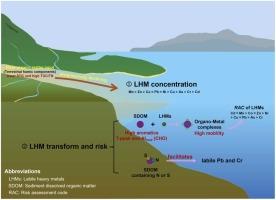基于同位素和分子特征的人为河口陆源有机质控制的沉积物中不稳定重金属
IF 11.3
1区 环境科学与生态学
Q1 ENGINEERING, ENVIRONMENTAL
引用次数: 0
摘要
不稳定重金属(LHM)是河口有机质(OM)控制金属迁移的最直接指标。本研究以珠江口富营养化和重金属(HM)污染为研究对象,研究沉积物中溶解OM与lhm之间的关系,从而了解金属风险机制。lhm在西海岸和河口地区表现出明显的堆积。土壤有机质和有机碳氮比的升高共同存在,稳定碳同位素特征降低,表明陆地有机质在很大程度上促进了土壤有机质的运输和积累。高腐殖化的陆源沉积物溶解有机质(SDOM)组分可能由于强大的相互作用而对大多数lhm提供更强的结合。SDOM分子分析表明,陆生、高芳香和稳定的物质增强了HM迁移率。而原位细菌或浮游植物转化的含氮和含硫DOM产物对活性Pb和Cr的贡献较大。这些结果表明,高芳香性和低生物反应性的SDOM促进了HM的迁移和风险,而陆地SDOM在很大程度上控制了HM的迁移和风险。这些观察结果为人类影响河口中HMs的存在和风险的机制提供了新的见解。本文章由计算机程序翻译,如有差异,请以英文原文为准。

Labile heavy metals in sediments controlled by terrestrial organic matter based on isotopic and molecular signatures in an anthropogenic estuary
Labile heavy metal (LHM) is greatly important as the most direct proxy of metal mobility, which is crucially controlled by organic matter (OM) in the estuaries. This work was performed in the Pearl River Estuary experienced eutrophication and heavy metal (HM) pollution, aiming to study the link between dissolved OM and LHMs in sediments, thereby understanding the metal risk mechanisms. LHMs exhibited pronounced accumulation in the west coast and river outlet areas. Co-occurrence of elevated LHMs and organic carbon versus nitrogen ratio, decreased stable carbon isotopic signature, suggested terrestrial OM largely facilitated the transport and accumulation of LHMs. Terrestrially derived sediment dissolved OM (SDOM) components with high humification may supply a stronger binding to most LHMs due to the powerful interactions. SDOM molecular analyses showed terrestrial, highly aromatic and stable substances enhanced HM mobility. Whereas, in situ bacteria or phytoplankton transformed DOM products containing nitrogen and sulfur made a greater contribution to labile Pb and Cr compared to others. These results implied SDOM with high aromaticity and low bio-reactivity promoted HM mobility and risk which was also considerably controlled by terrestrial SDOM. These observations offered new insights into the mechanisms involving the presence and risk of HMs in human-impacted estuaries.
求助全文
通过发布文献求助,成功后即可免费获取论文全文。
去求助
来源期刊

Journal of Hazardous Materials
工程技术-工程:环境
CiteScore
25.40
自引率
5.90%
发文量
3059
审稿时长
58 days
期刊介绍:
The Journal of Hazardous Materials serves as a global platform for promoting cutting-edge research in the field of Environmental Science and Engineering. Our publication features a wide range of articles, including full-length research papers, review articles, and perspectives, with the aim of enhancing our understanding of the dangers and risks associated with various materials concerning public health and the environment. It is important to note that the term "environmental contaminants" refers specifically to substances that pose hazardous effects through contamination, while excluding those that do not have such impacts on the environment or human health. Moreover, we emphasize the distinction between wastes and hazardous materials in order to provide further clarity on the scope of the journal. We have a keen interest in exploring specific compounds and microbial agents that have adverse effects on the environment.
 求助内容:
求助内容: 应助结果提醒方式:
应助结果提醒方式:


